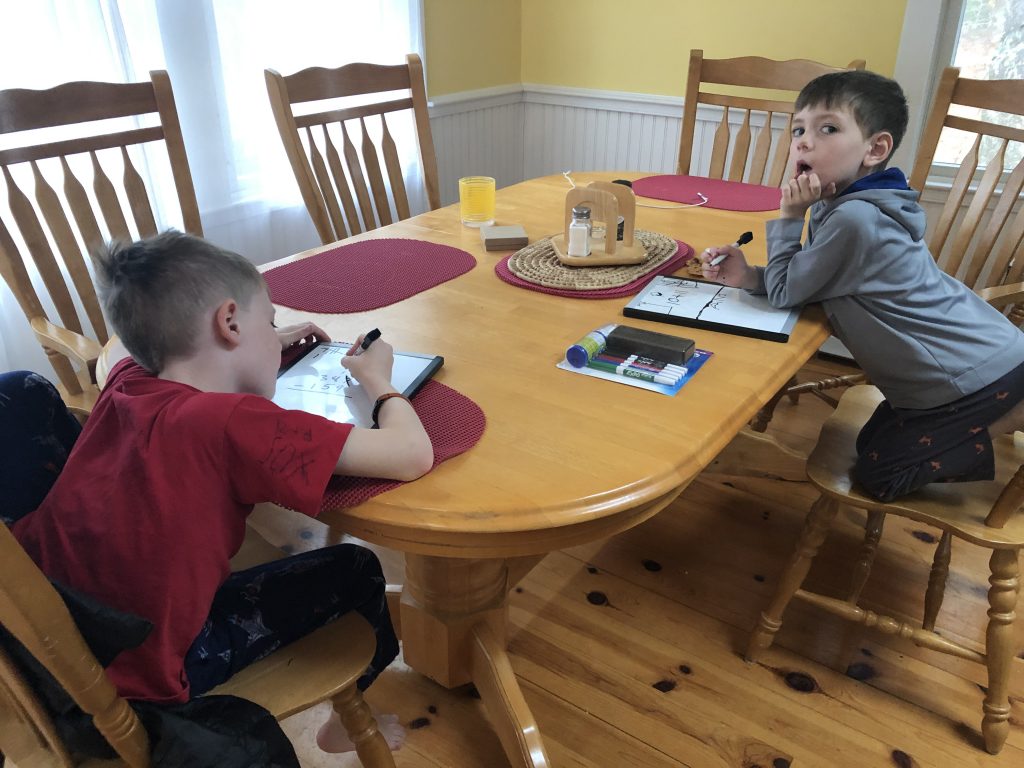
1) Make a schedule that is realistic for you
By now I am sure you have read that children ought to have a daily schedule. I encourage everyone to create one, but not one you find on the Internet. Make one that works for you and your personal family situation. If you want tips on making a quarantine homeschool schedule that works for your family, click this link. I recommend making a template for the “typical” day, but build in some flexibility to allow for changes in weather or work from home requirements like Zoom meetings.
2) Give your schooling a fun name.
Words matter. You can’t call what you are doing with you children each day simply “school”. The word “school” has meaning to children. It is geographical space they are now barred from entering filled with people they most likely will miss seeing on a daily basis. You need your own special term for the new learning activity you are engaging in together. Somehow my family started calling our daily learning routine “Mommy School.” Feel free to take that one if it works for your situation.
3) Start with a morning meeting
We make “Mommy School” as much like school as possible. (See the schedule building link for more specifics). One thing I strongly recommend is to start each day with a morning meeting. Many classrooms do this. The students gather together on the carpet and the teacher has them greet each other and share the plans for the day. As an education professor, this is a practice I teach my pre-service teachers in our social studies methods course because it builds a strong learning community. It is also nice way to share information, such as the daily schedule. Children find comfort in knowing what to expect.
In our quarantined homeschool version my 4 children gather on the kitchen floor greet each other in a silly way (robot voice, alien voice, as high pitched as you can, as low as you can, etc.) Then I read off the schedule for the day, previewing specific content we will address and activities we will do.
This meeting takes less then 5 minutes, but the transition is important. It is a clear indication to them that “mommy school” is beginning and wild-do-whatever-you-want time is done until 3:00pm.
4) Make sure the day includes a mix of technology and non-technology

Schedule your child’s day to include a balance of technology friendly educational activities and some activities that don’t involve staring at a screen. But you’re trying to work from home and you are also doing (fill in important thing here)? I get it. Truly I do. The problem is kids can’t stare at a screen from 9am-3pm, no matter how academic the content.
Let’s be honest, non-technology activities are harder on parents, so they are more time consuming. For this I recommend a flexible daily schedule. Schedule the self-guided screen time activities for your conference call, and other hands on-activities for when you are answering emails.

If you have a printer and are looking for non-technology activities you can print out I recommend you check out Teachers Pay Teachers. This website is a resource created by teachers to share content they make for their classrooms, while allowing them to make some cash on the side (Remember-no one goes into education to get rich). You can search by grade and subject.
You also want to be sure you encourage independence. Praise them like crazy when they do something without your support. This will encourage them to try it again in the future. The more independently they work, the more you can breathe.
5) Non-technology can’t be all paper and pencil
Children need to manipulate objects to fully engage their brains. They need to utilize as many senses as possible. Of course you can have them do worksheets you find online, but that can’t be everything. Have them:
- Build a tower with blocks
- Sort a toy they have a ton of by color and graph the results (in our home it is toy cars)
- Write on a whiteboard instead of paper
- Jump from number to number without falling in the “lava,”
- Sing as many learning songs as you can find. (Don’t worry-this website will provide more suggestions for activities in the coming days)
Why does this matter? For starters, the enemy of a homeschool parent is boredom. You can’t let them be bored. Any teacher will tell you boredom leads to misbehavior. Using only paper and pencil on worksheets gets old quickly. Also, it isn’t very multi-sensory, by that I mean utilizes several senses (sight, sound, taste, touch, smell). Highly stimulating multi-sensory engagement builds stronger neurological pathways in the brain. Pathways in the brain, accessed often, builds long term knowledge. This bring me to my next suggestion…
6) Don’t be afraid to repeat activities to build on prior knowledge.
Children forget things that are treated like a one and done. Repetition builds knowledge. Just because you sang a skip counting by 3’s song on Monday, doesn’t mean you can’t sing it again on Wednesday, and then again on Thursday. If you are looking for a skip counting by 3 song here is an extremely useful School House Rock classic song that children find catchy:
7) Be easy on yourself
These crazy unprecedented times are hard on all of us, kids included. Be easy on them, but also be easy on yourself. Even the best professional teachers have rough days. Good thing is you can learn from what didn’t work and try again tomorrow.